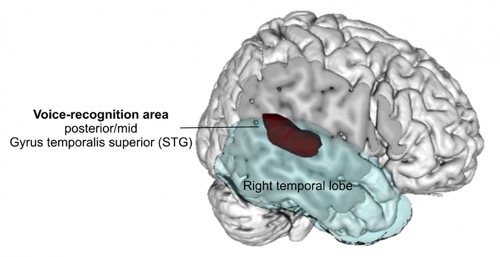Our personal assistant for voice recognition uses a convolution in the right temporal lobe.
MAX PLANCK INSTITUTE FOR HUMAN COGNITIVE AND BRAIN SCIENCES - We regularly find ourselves in situations in which we talk to others. We talk to friends in a different way than we do to strangers. One important skill for this is not just understanding what the other person is saying but also recognising who is talking. Therefore, the voice of our conversation partner helps us. Until now, scientists could not agree on exactly which regions in the brain allow us to recognise voices.
"Very valid statements about which brain areas are responsible for which functions are derived from investigations in patients with lesions. If a certain part of the brain is injured and therefore a certain function fails, both components can be related to each other", says Claudia Roswandowitz, scientist at the Max Planck Institute for Human Cognitive and Brain Sciences (MPI CBS) in Leipzig, and first author of a study which has revealed key findings about voice recognition. Roswandowitz, along with other researchers from the Research Group Neural Mechanisms of Human Communication, tested 58 patients with brain injuries and their capability to learn and recognise voices, especially those who had suffered a stroke. Additionally, the scientists looked at brain scans of the participants--high resolution images of their brain structures and injuries.
The neuroscientists found that especially persons with lesions in certain areas of the right posterior temporal lobe experienced difficulties recognizing voices. They assume that the posterior superior temporal gyrus, the STG, is crucial for voice recognition.

Especially persons with lesions in certain areas of the right posterior temporal lobe experienced difficulties recognizing voices. The MPI scientists assume that the posterior superior temporal gyrus, the STG, is crucial for voice recognition. Image courtesy of MPI CBS.
These findings were supported by a previous study at MPI CBS, whereby, a phenomenon commonly known as "voice blindness", phonagnosia, the inability to recognize voices, was investigated. The two involved study participants--the only ones known in Germany to be affected by phonagnosia--were not able to identify people by voice, even their own mum or child. Roswandowitz and her colleagues also detected that changes in and to the right temporal lobe led to the corresponding deficits. In comparison to the other patients with lesions, the causes did not lie in the failed brain structures but rather in their different brain activity.
"These findings improve our understanding of how the brain identifies voices and provide the basis in the search for effective therapies for those affected by phonagnosia, a fairly common deficit which is sometimes present from birth but especially after a stroke. In our studies nine per cent of the participants reported suffering from difficulties in recognizing voices, a problem that is almost unheard of in the medical sector. Thus, we have to raise awareness of this matter", says Roswandowitz.
Source: https://www.eurekalert.org/pub_releases/2017-12/mpif-aas122217.php
